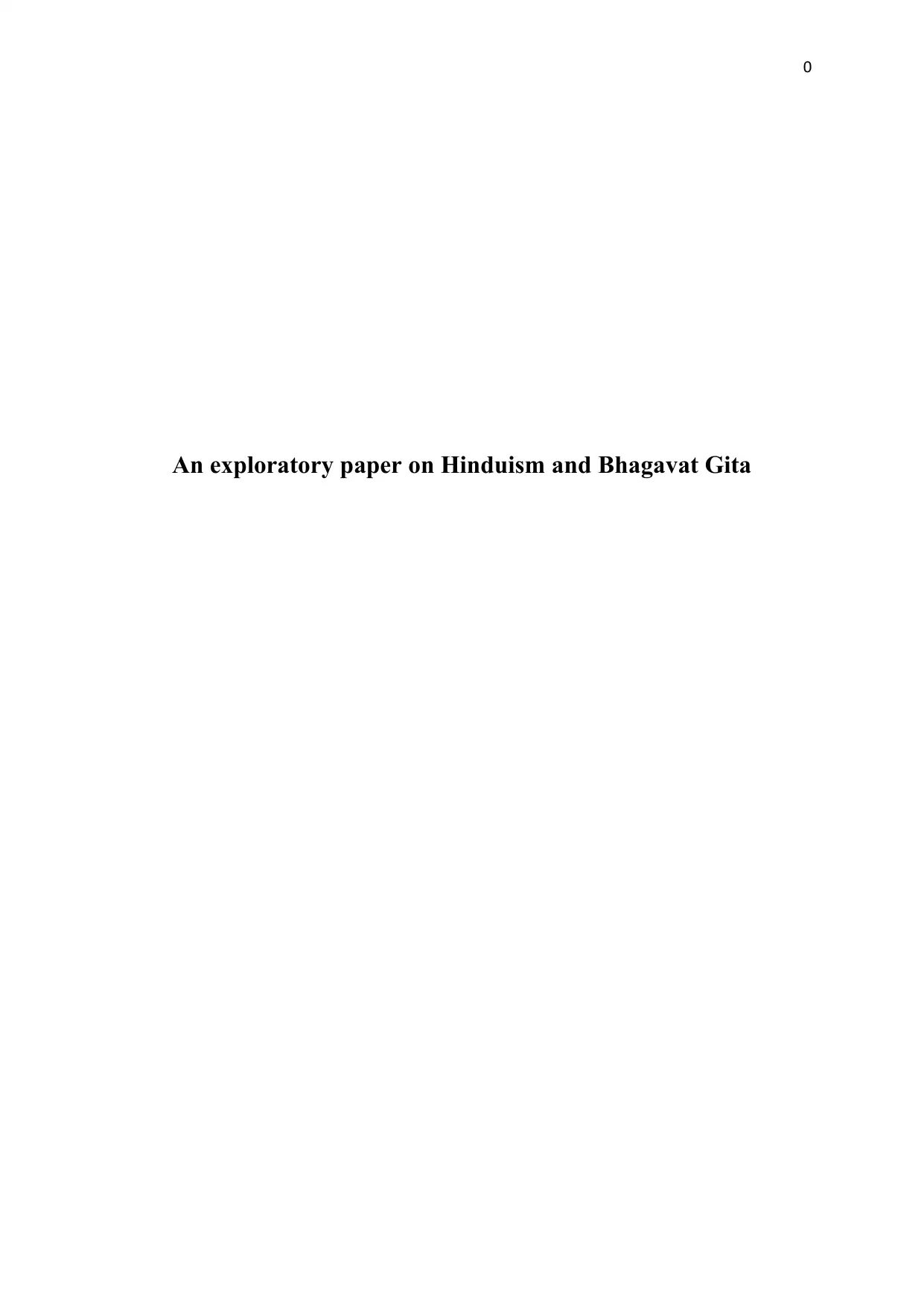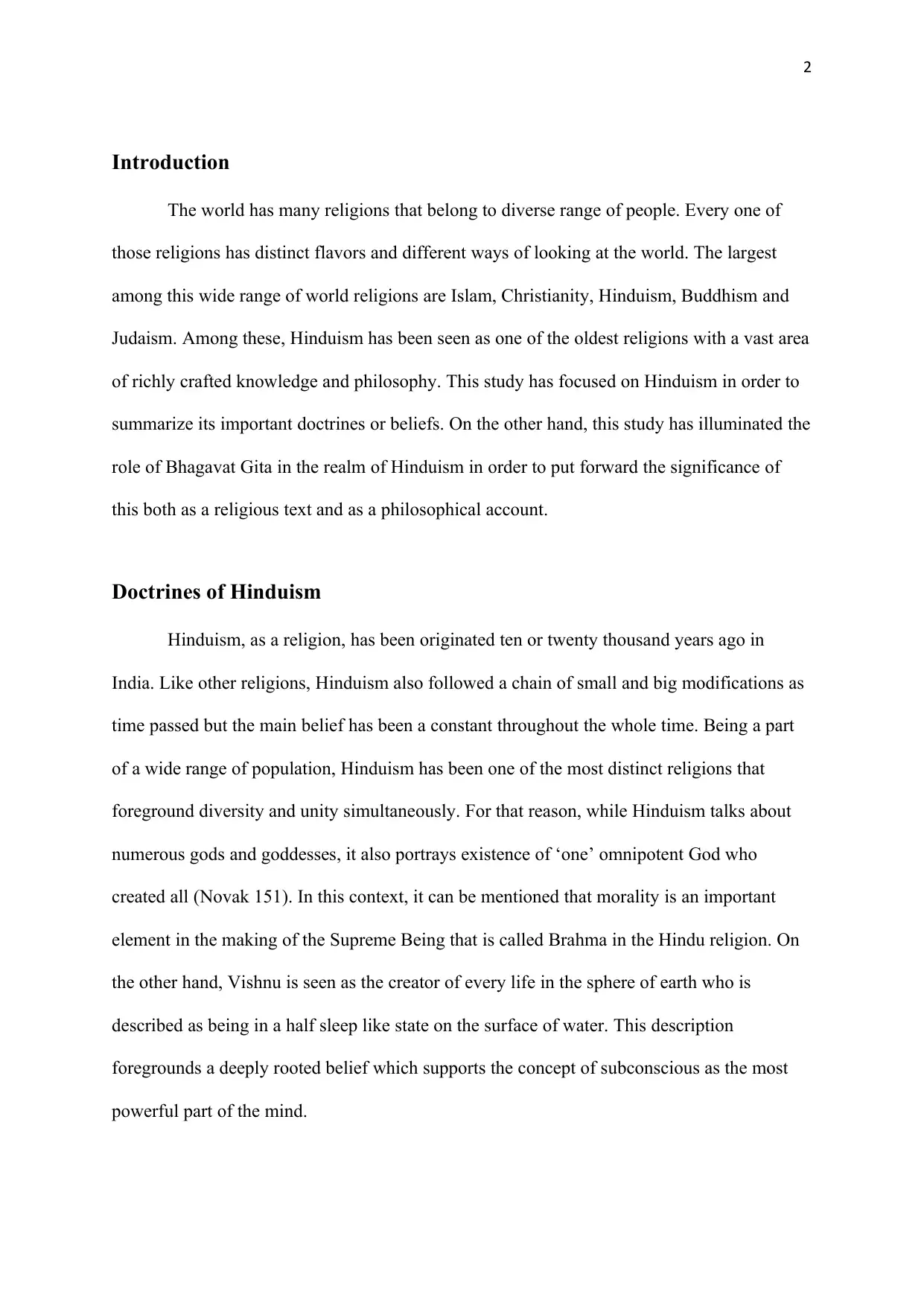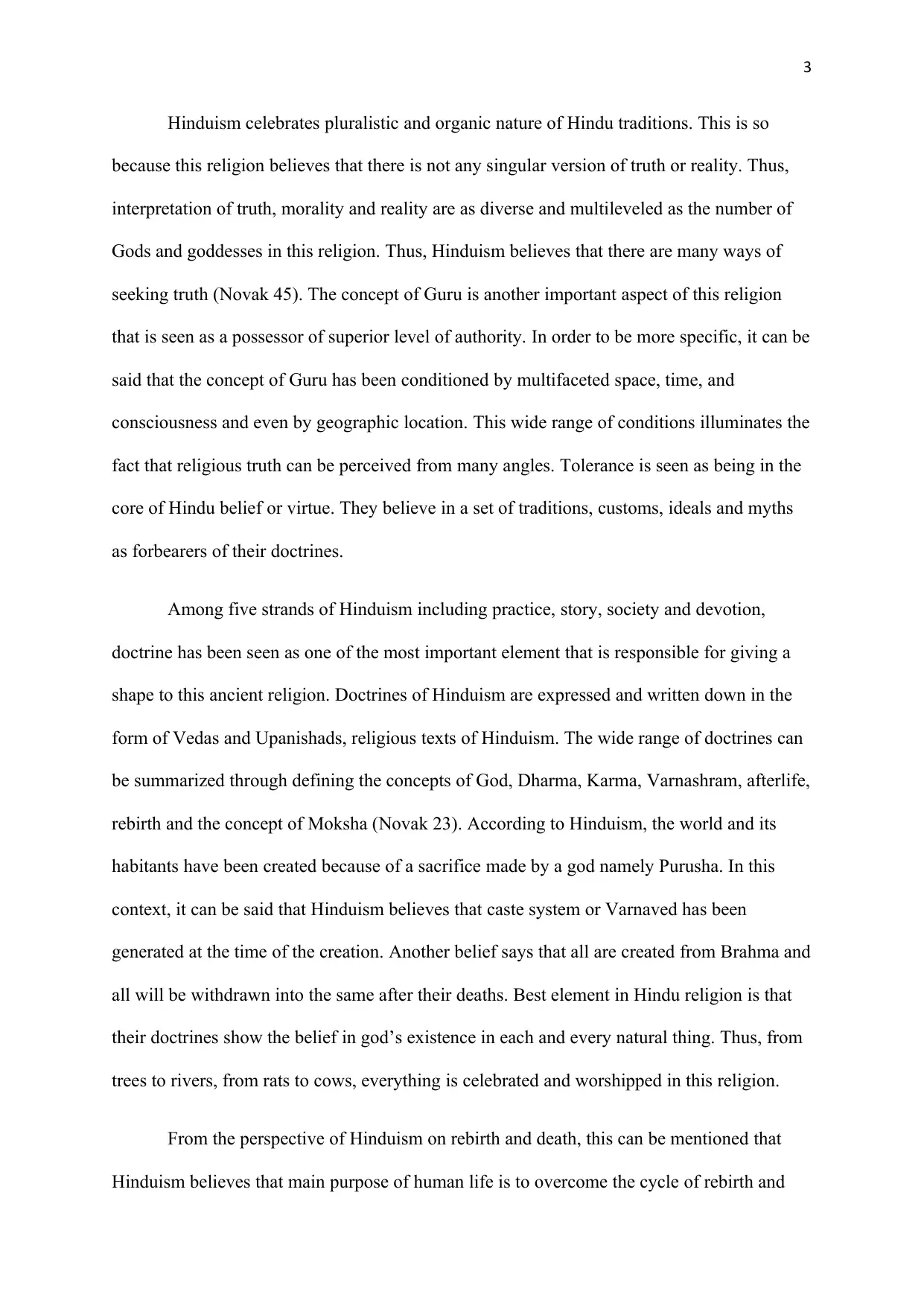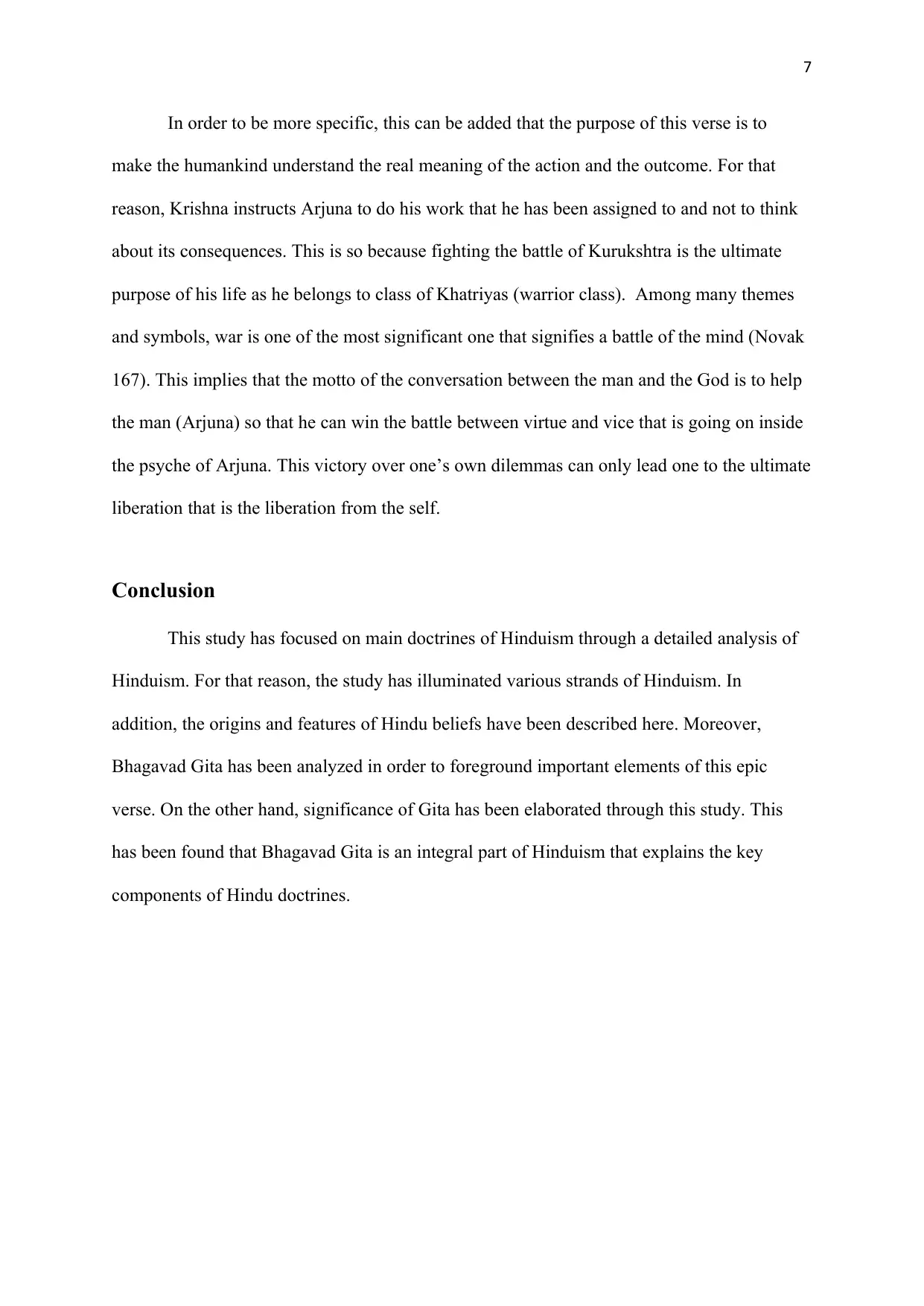Exploratory Paper on Hinduism and Bhagavat Gita
VerifiedAdded on 2023/05/31
|9
|2293
|445
AI Summary
This paper explores the doctrines of Hinduism and the significance of Bhagavat Gita as a religious and philosophical text. It discusses the concepts of God, Dharma, Karma, Varnashram, afterlife, rebirth, and Moksha. The paper also analyzes the role of Bhagavat Gita in Hinduism and its key components.
Contribute Materials
Your contribution can guide someone’s learning journey. Share your
documents today.

0
An exploratory paper on Hinduism and Bhagavat Gita
An exploratory paper on Hinduism and Bhagavat Gita
Secure Best Marks with AI Grader
Need help grading? Try our AI Grader for instant feedback on your assignments.

1
Table of Contents
Introduction................................................................................................................................2
Doctrines of Hinduism...............................................................................................................2
Exploration of Bhagavad Gita....................................................................................................5
Conclusion..................................................................................................................................7
Works cited................................................................................................................................8
Table of Contents
Introduction................................................................................................................................2
Doctrines of Hinduism...............................................................................................................2
Exploration of Bhagavad Gita....................................................................................................5
Conclusion..................................................................................................................................7
Works cited................................................................................................................................8

2
Introduction
The world has many religions that belong to diverse range of people. Every one of
those religions has distinct flavors and different ways of looking at the world. The largest
among this wide range of world religions are Islam, Christianity, Hinduism, Buddhism and
Judaism. Among these, Hinduism has been seen as one of the oldest religions with a vast area
of richly crafted knowledge and philosophy. This study has focused on Hinduism in order to
summarize its important doctrines or beliefs. On the other hand, this study has illuminated the
role of Bhagavat Gita in the realm of Hinduism in order to put forward the significance of
this both as a religious text and as a philosophical account.
Doctrines of Hinduism
Hinduism, as a religion, has been originated ten or twenty thousand years ago in
India. Like other religions, Hinduism also followed a chain of small and big modifications as
time passed but the main belief has been a constant throughout the whole time. Being a part
of a wide range of population, Hinduism has been one of the most distinct religions that
foreground diversity and unity simultaneously. For that reason, while Hinduism talks about
numerous gods and goddesses, it also portrays existence of ‘one’ omnipotent God who
created all (Novak 151). In this context, it can be mentioned that morality is an important
element in the making of the Supreme Being that is called Brahma in the Hindu religion. On
the other hand, Vishnu is seen as the creator of every life in the sphere of earth who is
described as being in a half sleep like state on the surface of water. This description
foregrounds a deeply rooted belief which supports the concept of subconscious as the most
powerful part of the mind.
Introduction
The world has many religions that belong to diverse range of people. Every one of
those religions has distinct flavors and different ways of looking at the world. The largest
among this wide range of world religions are Islam, Christianity, Hinduism, Buddhism and
Judaism. Among these, Hinduism has been seen as one of the oldest religions with a vast area
of richly crafted knowledge and philosophy. This study has focused on Hinduism in order to
summarize its important doctrines or beliefs. On the other hand, this study has illuminated the
role of Bhagavat Gita in the realm of Hinduism in order to put forward the significance of
this both as a religious text and as a philosophical account.
Doctrines of Hinduism
Hinduism, as a religion, has been originated ten or twenty thousand years ago in
India. Like other religions, Hinduism also followed a chain of small and big modifications as
time passed but the main belief has been a constant throughout the whole time. Being a part
of a wide range of population, Hinduism has been one of the most distinct religions that
foreground diversity and unity simultaneously. For that reason, while Hinduism talks about
numerous gods and goddesses, it also portrays existence of ‘one’ omnipotent God who
created all (Novak 151). In this context, it can be mentioned that morality is an important
element in the making of the Supreme Being that is called Brahma in the Hindu religion. On
the other hand, Vishnu is seen as the creator of every life in the sphere of earth who is
described as being in a half sleep like state on the surface of water. This description
foregrounds a deeply rooted belief which supports the concept of subconscious as the most
powerful part of the mind.

3
Hinduism celebrates pluralistic and organic nature of Hindu traditions. This is so
because this religion believes that there is not any singular version of truth or reality. Thus,
interpretation of truth, morality and reality are as diverse and multileveled as the number of
Gods and goddesses in this religion. Thus, Hinduism believes that there are many ways of
seeking truth (Novak 45). The concept of Guru is another important aspect of this religion
that is seen as a possessor of superior level of authority. In order to be more specific, it can be
said that the concept of Guru has been conditioned by multifaceted space, time, and
consciousness and even by geographic location. This wide range of conditions illuminates the
fact that religious truth can be perceived from many angles. Tolerance is seen as being in the
core of Hindu belief or virtue. They believe in a set of traditions, customs, ideals and myths
as forbearers of their doctrines.
Among five strands of Hinduism including practice, story, society and devotion,
doctrine has been seen as one of the most important element that is responsible for giving a
shape to this ancient religion. Doctrines of Hinduism are expressed and written down in the
form of Vedas and Upanishads, religious texts of Hinduism. The wide range of doctrines can
be summarized through defining the concepts of God, Dharma, Karma, Varnashram, afterlife,
rebirth and the concept of Moksha (Novak 23). According to Hinduism, the world and its
habitants have been created because of a sacrifice made by a god namely Purusha. In this
context, it can be said that Hinduism believes that caste system or Varnaved has been
generated at the time of the creation. Another belief says that all are created from Brahma and
all will be withdrawn into the same after their deaths. Best element in Hindu religion is that
their doctrines show the belief in god’s existence in each and every natural thing. Thus, from
trees to rivers, from rats to cows, everything is celebrated and worshipped in this religion.
From the perspective of Hinduism on rebirth and death, this can be mentioned that
Hinduism believes that main purpose of human life is to overcome the cycle of rebirth and
Hinduism celebrates pluralistic and organic nature of Hindu traditions. This is so
because this religion believes that there is not any singular version of truth or reality. Thus,
interpretation of truth, morality and reality are as diverse and multileveled as the number of
Gods and goddesses in this religion. Thus, Hinduism believes that there are many ways of
seeking truth (Novak 45). The concept of Guru is another important aspect of this religion
that is seen as a possessor of superior level of authority. In order to be more specific, it can be
said that the concept of Guru has been conditioned by multifaceted space, time, and
consciousness and even by geographic location. This wide range of conditions illuminates the
fact that religious truth can be perceived from many angles. Tolerance is seen as being in the
core of Hindu belief or virtue. They believe in a set of traditions, customs, ideals and myths
as forbearers of their doctrines.
Among five strands of Hinduism including practice, story, society and devotion,
doctrine has been seen as one of the most important element that is responsible for giving a
shape to this ancient religion. Doctrines of Hinduism are expressed and written down in the
form of Vedas and Upanishads, religious texts of Hinduism. The wide range of doctrines can
be summarized through defining the concepts of God, Dharma, Karma, Varnashram, afterlife,
rebirth and the concept of Moksha (Novak 23). According to Hinduism, the world and its
habitants have been created because of a sacrifice made by a god namely Purusha. In this
context, it can be said that Hinduism believes that caste system or Varnaved has been
generated at the time of the creation. Another belief says that all are created from Brahma and
all will be withdrawn into the same after their deaths. Best element in Hindu religion is that
their doctrines show the belief in god’s existence in each and every natural thing. Thus, from
trees to rivers, from rats to cows, everything is celebrated and worshipped in this religion.
From the perspective of Hinduism on rebirth and death, this can be mentioned that
Hinduism believes that main purpose of human life is to overcome the cycle of rebirth and
Paraphrase This Document
Need a fresh take? Get an instant paraphrase of this document with our AI Paraphraser

4
death. This is so because the main motto of the soul is to be reunited with the Supreme Being,
Brahma at the end (Novak 211). Thus, it can be said that Hinduism believes in after life and
concept of rebirth but ultimately supports the concept of Moksha or liberation from the self.
Klesh or suffering has always been connected with life while Mukti or peace has been
connected with death or end of human life. This implies that Hinduism sees human beings as
server of greater purpose and not just as materialistic beings. For this reason, mind or soul has
always given more preference than the body that is prone to destruction.
Another important element in Hinduism is the concept of Karma. The earliest texts of
Hinduism supports hereditary preferences as forbearers of fate but later this religion became
remarkable for discussing the role and significance of action in the making of one’s fate
(Novak 317). Human actions have been termed as the word Karma that has now became its
one and only signifier and that has no substitution in any language. It can be stated that
Karma has been explained in Hinduism as one’s acts throughout their lives and their
respective consequences. It is believed that everyone paves their own ways to the hell or to
the heaven.
Concept of Dharma is important here which can be defined as list of moral duties of
human beings. Hinduism believes that if someone acts against the norms of Dharma then the
person is doomed to be punished in the afterlife or in the next life. The motto of this teaching
is to motivate people to act morally and ethically in order to restrain them from making
crimes. In this context, it can be mentioned that Hinduism foregrounds several principles of
living such as contentment, tolerance, honesty, modesty, forgiveness and most importantly,
truthfulness (Novak 278). Yoga has been included in the doctrines of Hinduism as the only
paths that can lead to the Supreme Being before being dead. Unlike many Western
interpretations of this word, Yoga stands for an absolute state of knowledge that makes an
individual aware of the purpose of the self. Moreover, immortality of souls has been given
death. This is so because the main motto of the soul is to be reunited with the Supreme Being,
Brahma at the end (Novak 211). Thus, it can be said that Hinduism believes in after life and
concept of rebirth but ultimately supports the concept of Moksha or liberation from the self.
Klesh or suffering has always been connected with life while Mukti or peace has been
connected with death or end of human life. This implies that Hinduism sees human beings as
server of greater purpose and not just as materialistic beings. For this reason, mind or soul has
always given more preference than the body that is prone to destruction.
Another important element in Hinduism is the concept of Karma. The earliest texts of
Hinduism supports hereditary preferences as forbearers of fate but later this religion became
remarkable for discussing the role and significance of action in the making of one’s fate
(Novak 317). Human actions have been termed as the word Karma that has now became its
one and only signifier and that has no substitution in any language. It can be stated that
Karma has been explained in Hinduism as one’s acts throughout their lives and their
respective consequences. It is believed that everyone paves their own ways to the hell or to
the heaven.
Concept of Dharma is important here which can be defined as list of moral duties of
human beings. Hinduism believes that if someone acts against the norms of Dharma then the
person is doomed to be punished in the afterlife or in the next life. The motto of this teaching
is to motivate people to act morally and ethically in order to restrain them from making
crimes. In this context, it can be mentioned that Hinduism foregrounds several principles of
living such as contentment, tolerance, honesty, modesty, forgiveness and most importantly,
truthfulness (Novak 278). Yoga has been included in the doctrines of Hinduism as the only
paths that can lead to the Supreme Being before being dead. Unlike many Western
interpretations of this word, Yoga stands for an absolute state of knowledge that makes an
individual aware of the purpose of the self. Moreover, immortality of souls has been given

5
most importance in Hinduism that explains the fact that there is no escape from one’s Karma
even after the death or ever.
Exploration of Bhagavad Gita
Bhagavad Gita is a part of Mahabharata, the Hindu epic that has been written in
Sanskrit in the form of a verse. This scripture has multilayered significance today. This is so
because not only this is a great work of literature but also a great philosophical text. On the
other hand, many key concepts in Hindu spirituality have been introduced through this epic
verse. With 700 poems and 18 chapters, Bhagavad Gita becomes one of the most significant
mythological texts that explain the place and role of God and humans as per Hinduism.
One of the most important features of this verse is that Gita questions the basic
assumption of Hinduism that preaches to retain a life of a monk in order to get salvation and
peace. As per the plot of this verse or of Mahabharata, two groups of people belonging from
the same royal family fight for the single throne and in the end the righteous party wins
(Novak 153). Involvement of Gods is less in this epic unlike other earlier mythological
accounts and the only role Krishna (God) has played here is the role of a guide. In this regard,
this can be added that Gita has been included in this epic as exchange of dialogues between
Arjuna and Krishna. Arjuna has come to fight his own family members, whom he dearly
loves, just because they are on the opposite party and thus is highly confused regarding
whether to fight or to go back. In this conflicting moment, Krishna, the driver of his Rath
(chariot) preaches him about the main purpose of his life and about the ways of the world.
Thus, Gita is a medium of making Arjuna realize his actual duties as a real warrior. In other
words, Gita foregrounds a conversation between the god and the man. The motto of this
conversation is to convince Arjuna to battle on the ground that no one is immortal and
everyone’s fate has already been decided by the ultimate supreme God.
most importance in Hinduism that explains the fact that there is no escape from one’s Karma
even after the death or ever.
Exploration of Bhagavad Gita
Bhagavad Gita is a part of Mahabharata, the Hindu epic that has been written in
Sanskrit in the form of a verse. This scripture has multilayered significance today. This is so
because not only this is a great work of literature but also a great philosophical text. On the
other hand, many key concepts in Hindu spirituality have been introduced through this epic
verse. With 700 poems and 18 chapters, Bhagavad Gita becomes one of the most significant
mythological texts that explain the place and role of God and humans as per Hinduism.
One of the most important features of this verse is that Gita questions the basic
assumption of Hinduism that preaches to retain a life of a monk in order to get salvation and
peace. As per the plot of this verse or of Mahabharata, two groups of people belonging from
the same royal family fight for the single throne and in the end the righteous party wins
(Novak 153). Involvement of Gods is less in this epic unlike other earlier mythological
accounts and the only role Krishna (God) has played here is the role of a guide. In this regard,
this can be added that Gita has been included in this epic as exchange of dialogues between
Arjuna and Krishna. Arjuna has come to fight his own family members, whom he dearly
loves, just because they are on the opposite party and thus is highly confused regarding
whether to fight or to go back. In this conflicting moment, Krishna, the driver of his Rath
(chariot) preaches him about the main purpose of his life and about the ways of the world.
Thus, Gita is a medium of making Arjuna realize his actual duties as a real warrior. In other
words, Gita foregrounds a conversation between the god and the man. The motto of this
conversation is to convince Arjuna to battle on the ground that no one is immortal and
everyone’s fate has already been decided by the ultimate supreme God.

6
One of the most important themes of this verse is that God is everywhere and God is
supreme who is unaffected, abstract and constant. Unlike other spiritual texts, this text sides
with the idea that God has no specific gender but is actually the mixture of every kind of
gender. Apart from that, Gita says that there is a permanent self in each and everyone that
cannot be destroyed even after death (Novak 44). This concept of soul has been termed as
Atman in this epic that has been described as an unchanging and real essence of every
species. On the other hand, this text considers the fact that the world is transient where every
matter is mortal. In other words, everything, that constitutes the Nature, has a limited
existence. This implies that reality, that we see, is impermanent and the actual reality exists
beneath the skin.
Furthermore, some important concepts have been introduced through Bhagavad Gita
that includes concepts of Karma, Dharma, Bhakti and Jnana. All these are chosen as different
types of ways that leads one to the ultimate Supreme Being. Among these, Bhakti refers to a
kind of unconditional devotion and surrender to the God. Jnana can be translated as
knowledge but actually this stands for a kind of wisdom that lets a person see the true essence
of Brahma or God. On the other hand, the concept of Dharma is similar to the concept of
righteousness. The difference lies in the fact that in this verse, dharma has been described as
something that situational and not universal (Novak 39). For example, Arjuna and his
opponents have been involved in the same bloodshed and in the same fight but the difference
lies on the fact that Arjuna has been fighting for the right reason and for the betterment of the
society. In this regard, this can be mentioned that concept of Dharma has been presented in a
very complex way in this verse that includes various duties or roles of a single person. It has
been mentioned that a person has to be dutiful to each and every role that the person plays in
the lifetime.
One of the most important themes of this verse is that God is everywhere and God is
supreme who is unaffected, abstract and constant. Unlike other spiritual texts, this text sides
with the idea that God has no specific gender but is actually the mixture of every kind of
gender. Apart from that, Gita says that there is a permanent self in each and everyone that
cannot be destroyed even after death (Novak 44). This concept of soul has been termed as
Atman in this epic that has been described as an unchanging and real essence of every
species. On the other hand, this text considers the fact that the world is transient where every
matter is mortal. In other words, everything, that constitutes the Nature, has a limited
existence. This implies that reality, that we see, is impermanent and the actual reality exists
beneath the skin.
Furthermore, some important concepts have been introduced through Bhagavad Gita
that includes concepts of Karma, Dharma, Bhakti and Jnana. All these are chosen as different
types of ways that leads one to the ultimate Supreme Being. Among these, Bhakti refers to a
kind of unconditional devotion and surrender to the God. Jnana can be translated as
knowledge but actually this stands for a kind of wisdom that lets a person see the true essence
of Brahma or God. On the other hand, the concept of Dharma is similar to the concept of
righteousness. The difference lies in the fact that in this verse, dharma has been described as
something that situational and not universal (Novak 39). For example, Arjuna and his
opponents have been involved in the same bloodshed and in the same fight but the difference
lies on the fact that Arjuna has been fighting for the right reason and for the betterment of the
society. In this regard, this can be mentioned that concept of Dharma has been presented in a
very complex way in this verse that includes various duties or roles of a single person. It has
been mentioned that a person has to be dutiful to each and every role that the person plays in
the lifetime.
Secure Best Marks with AI Grader
Need help grading? Try our AI Grader for instant feedback on your assignments.

7
In order to be more specific, this can be added that the purpose of this verse is to
make the humankind understand the real meaning of the action and the outcome. For that
reason, Krishna instructs Arjuna to do his work that he has been assigned to and not to think
about its consequences. This is so because fighting the battle of Kurukshtra is the ultimate
purpose of his life as he belongs to class of Khatriyas (warrior class). Among many themes
and symbols, war is one of the most significant one that signifies a battle of the mind (Novak
167). This implies that the motto of the conversation between the man and the God is to help
the man (Arjuna) so that he can win the battle between virtue and vice that is going on inside
the psyche of Arjuna. This victory over one’s own dilemmas can only lead one to the ultimate
liberation that is the liberation from the self.
Conclusion
This study has focused on main doctrines of Hinduism through a detailed analysis of
Hinduism. For that reason, the study has illuminated various strands of Hinduism. In
addition, the origins and features of Hindu beliefs have been described here. Moreover,
Bhagavad Gita has been analyzed in order to foreground important elements of this epic
verse. On the other hand, significance of Gita has been elaborated through this study. This
has been found that Bhagavad Gita is an integral part of Hinduism that explains the key
components of Hindu doctrines.
In order to be more specific, this can be added that the purpose of this verse is to
make the humankind understand the real meaning of the action and the outcome. For that
reason, Krishna instructs Arjuna to do his work that he has been assigned to and not to think
about its consequences. This is so because fighting the battle of Kurukshtra is the ultimate
purpose of his life as he belongs to class of Khatriyas (warrior class). Among many themes
and symbols, war is one of the most significant one that signifies a battle of the mind (Novak
167). This implies that the motto of the conversation between the man and the God is to help
the man (Arjuna) so that he can win the battle between virtue and vice that is going on inside
the psyche of Arjuna. This victory over one’s own dilemmas can only lead one to the ultimate
liberation that is the liberation from the self.
Conclusion
This study has focused on main doctrines of Hinduism through a detailed analysis of
Hinduism. For that reason, the study has illuminated various strands of Hinduism. In
addition, the origins and features of Hindu beliefs have been described here. Moreover,
Bhagavad Gita has been analyzed in order to foreground important elements of this epic
verse. On the other hand, significance of Gita has been elaborated through this study. This
has been found that Bhagavad Gita is an integral part of Hinduism that explains the key
components of Hindu doctrines.

8
Works cited
Novak, Philip. The world's wisdom: Sacred texts of the world's religions. HarperCollins, New
York City: US. 1994. Print.
Works cited
Novak, Philip. The world's wisdom: Sacred texts of the world's religions. HarperCollins, New
York City: US. 1994. Print.
1 out of 9
![[object Object]](/_next/static/media/star-bottom.7253800d.svg)





